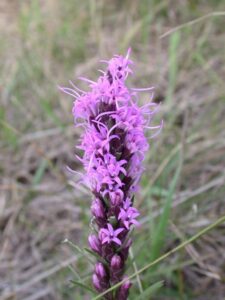Pollinator Plant Care
Aromatic Aster; symphyotrichum oblongifolium
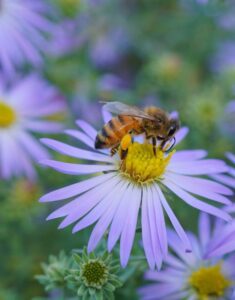
- Sun Exposure; Full/part
- Soil Moisture: Medium dry; dry
- Height: 2-4 feet; Spacing 12-18 inches
- Blooms: Purple-Pinkish Purple blossoms in August-October
- Aggressiveness; Medium by rhizomes
- Stiff stems will branch out slowly to create bush-like appearance which will be completely covered in light purple flowers
- Flowers do not have aroma, despite name, but leaves do if crushed
Sky Blue Aster; symphyotrichum oolentangiense

- Sun Exposure; Prefers full sun but will tolerate some shade
- Soil Moisture: Medium to dry; well drained
- Height: 2-3 feet; spacing 1-2 foot
- Bright and showy blue blossoms in August-October
- Attracts: Small bees, butterflies, skippers, wasps
- Non-Aggressive
- Short lived
- Leaf surface is similar to Smooth Blue Aster although is rough to touch
Frost Aster; Symphyotrichum sericeum
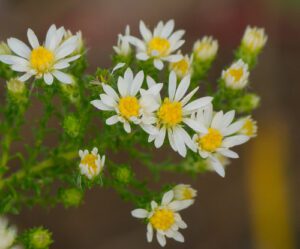
- Sun Exposure; Full
- Soil Moisture: medium-wet to dry
- Height: 3 feet; Spacing 2-3 feet
- Blooms; white blossoms in September, October
- Attracts bees and birds
- Aggressive; spreads by seeds and rhizomes
- Germination code; C=60
Smooth Aster; symphyotrichum laeve
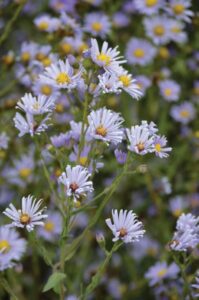
- Sun Exposure; Full, part
- Soil Moisture: Medium-wet to medium-dry
- 4 feet tall; Spacing 18-24 inches
- Blue blossoms in August-October
- Attracts: Butterflies, moths, and birds for seeds and nesting
- Host plant for Silvery Checkerspot and Pearl Crescent butterflies
- Aggressiveness; Spreads slowly by rhizomes
- Larval host plant for Silvery Checkerspot and Pearl Crescent butterflies
- Tough stem allows plant to stand tall
- Long lived;
- Closely resembles Sky Blue Aster
Black Eyed Susan; Rudbeckia Hirta

- Sun Exposure; Full to partial
- Soil Moisture; Medium wet to medium dry
- Height: 1-3 feet tall; Space 10-12 inches
- Yellow Blossoms June to October
- Easy to grow and great nectar source
- Biennial but reseeds;
- Host to Silvery Checkerspot larva
Blanket Flower; Gaillardia
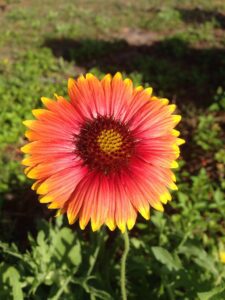
- Sun Exposure; Full
- Soil Moisture; Dry, well drained soil
- Height: 1-3 feet tall;
- Yellow-Burgundy Blossoms usually early to late summer
- Attracts: Bees, butterflies, other pollinators
- Aggressiveness; low by seed
- Short-lived, 2-3 years; Divide in year 2
- Deadhead to increase bloom time
Dense or Marsh Blazing Star; Liatris Spicata
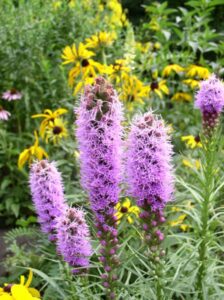
- Sun Exposure: Full, Partial
- Soil Moisture: Medium to moist
- Height: up to 5 feet; spacing 1-2 feet
- Purple blooms; purple in July, August, September
- Attracts: bees, butterflies, other insects, birds, sphynx moths
- Alternating leaves are grass like.
- Mix with grasses and robust flowers to lend support
- Dotted Blazing Star; Liatris punctata

- Sun Exposure: Full
- Moisture; Dry/medium
- Height; 1-2 feet
- Purple pink blossoms in July-September
- Attracts: Bees, butterflies, hummingbirds, songbirds
- Aggressiveness; Low by seed
- Soil: sand, loam, clay
Meadow Blazing Star; Liatris Ligulstylis

- Ultimate Monarch magnet
- Sun: Full, partial
- Moisture; medium-wet, medium, medium-dry
- Height up to 4 feet
- Requires rich loamy soil
- Purple blossoms in July, August, September
- Attracts: Bees, butterflies, Hummingbirds, songbirds
- Tolerates poor soil, partners well with Gray Headed Yellow Coneflower, Rattlesnake Master, Mountain Mint
Prairie Blazing Star; Liatris pycnostachya
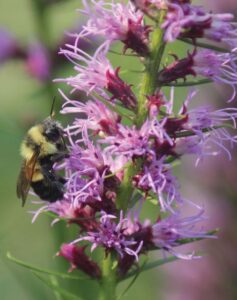
- Sun Exposure: Full
- Moisture; medium; moist
- Height 3-5 feet
- Purple, pink blossoms in July-September
- Attracts butterflies, moths, bees, hummingbirds, and birds
- Aggressiveness; Low by seed
- Plant with grasses and sturdy flowers to provide support and prevent flopping.
- One of earliest of Liatris to bloom
Rough Blazing Star; Liatris Aspera
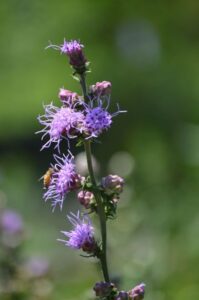
- Sun: Full/partial
- Moisture; Dry to Medium
- Height; 2-4 feet
- Purple blossoms in August, September
- Attracts: Bees, butterflies, hummingbirds, songbirds
- Aggressiveness: low by seed
- Blooms start at top
Blue False Indigo; Baptisia australis
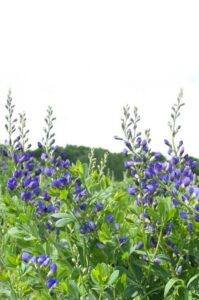
- Sun Exposure: full to part
- Soil Moisture: medium to moist
- Height: 3-5 feet
- Blooms: Blue blossoms May-July
- Attracts: bees, butterflies, game birds, song birds
- Aggressiveness: low by seed
- Emerging plant resembles asparagus
Blue Mistflower; Conoclinium coelestinum
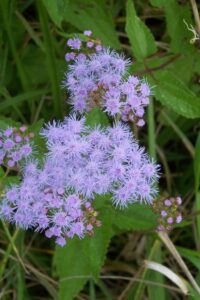
- Sun exposure; Partial
- Soil Moisture: Medium-wet to medium-dry
- Height-2 feet; spacing 12-24 inches
- Blue blossoms in September, October, form clusters
- Attracts late season butterflies
- Aggressiveness: medium by rhizome
- Can be found in savanna areas in dense stands
False Boneset; Brickellia eupatorioides
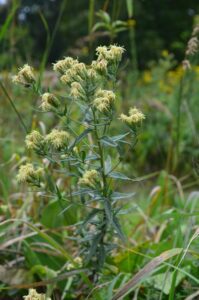
- Sun exposure: Full; Partial
- Moisture: Medium-dry to dry
- Height: 3 feet; roots to 17 feet deep
- Abundant fragrant cream blossoms in August; September
- Attracts: Bees, butterflies, moths
- Aggressiveness: Not aggressive
- Deer resistant
- Resembles Tall Boneset
Tall Boneset; Eupatorium Altissimum
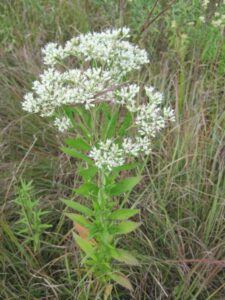
- Sun Exposure: Full to Partial
- Moisture; Medium-Wet to Medium-dry
- Height: 4 feet
- Attracts: Butterflies, bees, wasps
- Aggressiveness: somewhat
- Flattish clusters of dull white blooms; August, September; looks like regular Boneset; also resembles White Snakeroot blooms
- Opposite leaves have prominent vine.
- Also called Tall Thoroughwort
Boneset; Eupatorium Perfoliatum
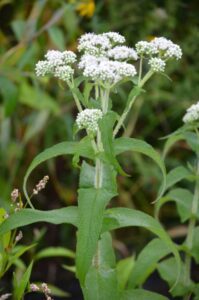
- Sun exposure: Full/partial
- Moisture: Medium, moist, wet
- Height 3-4 feet
- Roundish heads of white flowers July-September
- Attracts: Bees, butterflies, birds
- Leaves joined at base, appearing to surround stem
- Pair with Dense Blazing Star for attractive display
Canada Milkvetch; Astragalus canadensis
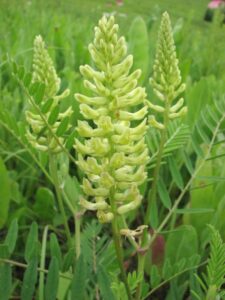
- Sun Exposure: full sun
- Soil Moisture: dry to medium
- Height: 2-3 feet
- Blooms: Creamy yellow blossoms July-October
- Attracts: bees, butterflies, game birds, hummingbirds, songbirds
- Aggressiveness: medium by seed
- Biennial but reseed
- Tap roots so not easily moved
Round Headed Bush Clover; lespedeza capitata
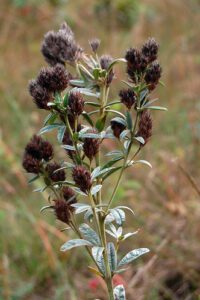
- Sun exposure; Full-to very light shade
- Soil Moisture: Medium-dry; does well in dry sandy soil
- Height; 2-4 feet; spacing 1-2 feet
- Cream-greenish blossoms in September, October, form clusters
- Host to Silver Spotted Skipper, Hoary Edge, and Southern & Northern Cloudywing Butterflies; & Bella Moth
- Foliage high in protein for mammalian wild life including deer, rabbits, and muskrat
- Seeds are food source for gamebirds and songbirds; including Mourning Dove, Bobwhite, Turkey and Junco
- Germination code: moist stratification-10 days; sandpaper scarification
Columbine; Aquilegia canadensis
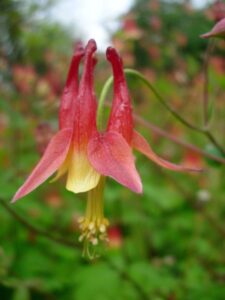
- Sun exposure, full, partial, or shade
- Soil Moisture: Medium to dry
- Red blossoms in April, May, June
- Height:2 feet; spacing; 10-17 inches
- Attract bees, butterflies, hummingbirds
- Aggressiveness:
- One of first plants to provide nectar
- Deer resistant
Compass Plant
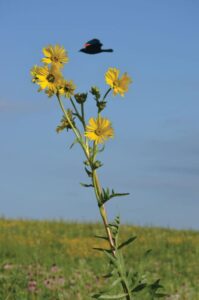
- Sun exposure, full, partial
- Soil Moisture: Medium-wet to medium-dry
- Yellow blossoms July-September
- Height: up to 8 feet; spacing: 3-4 feet
- Attract bees, butterflies, hummingbirds
- Aggressiveness: low by seed
- Leaves have tendency to orient themselves north-south
- Long lived; long taproot
Gray Headed Yellow Coneflower; Ratibida pinnata
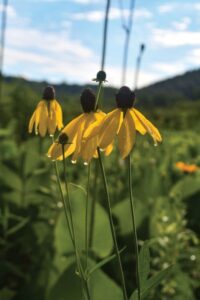
- Sun Exposure: Full to partial
- Soil Moisture: Dry to wet
- Height: 3-6 feet
- Blooms: Yellow blossoms July to September
- Attracts: Bees, butterflies, songbirds
- Aggressiveness: Medium by seed
Orange Coneflower; Rudbeckia Fulgida
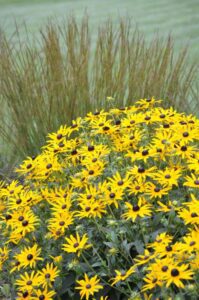
- Sun exposure; full to partial
- Soil Moisture; medium; does best in rich soil
- Height 2–4 feet; spacing 1-2”
- Blooms July-September
- Yellow-orange blossoms
- Dead-head to prolong blooming
- A favorite of butterflies; good nectar source for other pollinating insects
Pale Purple Coneflower; Echinacea Pallida
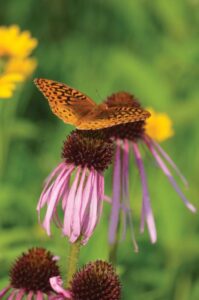
- Sun Exposure: Full
- Moisture; Dry to Medium
- Height 3-5 feet
- Purple blossoms in May-July
- Aggressiveness: Low by seed
- Attracts: bees, butterflies, hummingbirds, birds;
- More drought resistant than Purple Coneflower
Prairie Coneflower; Ratibida columnifera
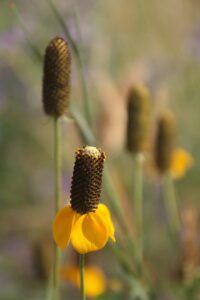
- Also called Long-headed Coneflower or Mexican Hat
- Sun Exposure; Full to half
- Soil Moisture: Well drained; Medium-dry; tolerates drought
- Height: 1-3 feet; Plant in groups or masses for more effective display
- Attracts: Bees, butterflies
- Aggressiveness; not long lived, but may reseed
- Showy blossoms from June to September
- Blossoms are Dark Orange, Yellow rays with Dark Brown center disk
Good companions include Butterfly Weed (Asclepias tuberosa), Whorled Milkweed (Asclepias verticillata), Asters, Gaillardia, Monarda, Penstemon
Lanceleaf Coreopsis; Coreopsis lanceolata
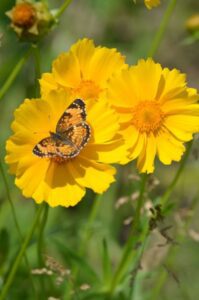
- Sun Exposure; full to light shade
- Soil Moisture; dry; medium
- Height: 1-2 feet;
- Blooms: Yellow blossoms June; July
- Attracts: butterflies & bees
- Aggressiveness: medium by seed
- Deer resistant
- Deadhead to extend bloom time.
- Showy plant!
Prairie (Stiff) Coreopsis; Coreopsis Palmata
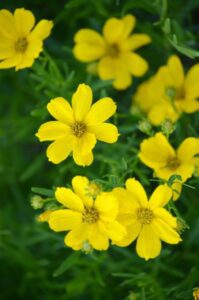
- Sun Exposure; Full
- Soil Moisture; Medium to dry; tolerant to drought
- Height 2-3 feet; Spacing 12-18 inches
- Yellow blooms in June-August
- Aggressiveness; Medium by rhizomes
- Attracts: Bees and butterflies for nectar; Birds for seeds
- Beekeepers consider all Coreopsis species to be good honey sources
- Deer resistant
Tall Coreopsis; Coreopsis Tripteris

- Sun Exposure; Full-Partial
- Soil Moisture; Medium to moist
- Height: 3-6 feet
- Yellow blooms July-September
- Attracts: Bees, butterflies, birds
- Aggressiveness: low by seed
- Beekeepers consider all Coreopsis species to be good honey sources
- Coreopsis plants are sometimes called tickseed.
Culver’s Root; Veronicastrum virginicum
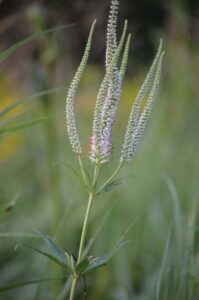
- Sun Exposure; full-partial;
- Soil Moisture; medium to moist
- Height: 5’ tall; 2-3’spacing
- Blooms: White flower spires; June-August
- Attracts: butterflies and solitary bees
- Aggressiveness: Low by seed; creeps slowly by rootstocks; can be divided
- Low palatability for deer
Cup Plant; Silphium Perfoliatum
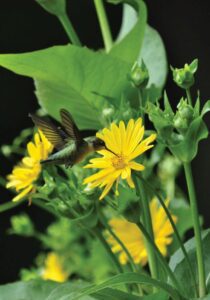
- Sun Exposure; full/partial
- Soil moisture: Medium-wet, Medium
- Height- 6 feet; spacing 2-4 feet apart
- Yellow blooms in July, August, September
- Butterflies feed on nectar, and birds on seeds
- Leaves clasp around stem and form cup around stems, which holds water which attracts birds and other wildlife
Evening Primrose; Oenothera biennis
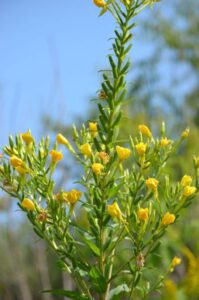
- Sun Exposure; Full, Partial
- Moisture: Medium-Wet to dry
- Height: up to 6 feet
- Yellow blooms in June thru October
- Attracts: Butterflies, bee, moths
- Aggressiveness: Medium
- Biennial but reseeds; growth vegetative in first year, blooms and seeds in second year
Foxglove Beardtongue; Penstemon digitalis
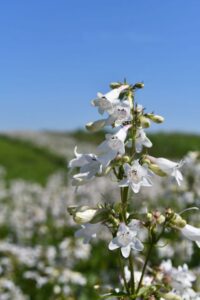
- Sun: Full, partial
- Moisture; medium to moist
- Height; 2-3 feet
- Blooms: Tubular-shaped white blossoms in May-July
- Attracts: Butterflies, long-tongued bees, hummingbirds
- Also attracts butterflies and birds
- Deer resistant
- Also called Smooth Penstemon
Golden Alexanders Zizio Aurea
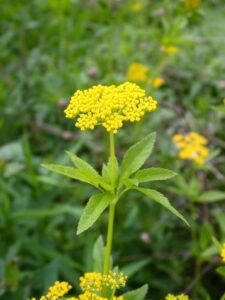
- Sun Exposure; Full – Partial
- Soil Moisture; Medium wet to medium dry
- Height 3 feet; Spacing 1-2 feet
- Yellow blossoms April-June
- Attracts: Bees, butterflies
- Aggressiveness: Low by seed
- Short lived, but will self-seed
- Every pollinator garden needs these! A great early nectar source!
Caution-it can be confused with non-native Wild Parsnip, although parsnip is taller and blooms later; Parsnip can cause painful skin burns.
Stiff Goldenrod; Solidago rigida
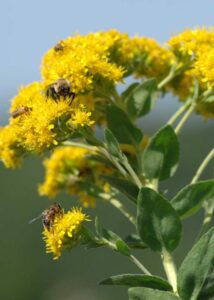
- Sun Exposure; Full/partial
- Soil Moisture; Dry to moist
- Height 3-5 feet; Spacing 1-2 feet
- Large, Flat topped yellow blooms August to September
- Attracts: Butterflies, bees, game and song birds;
- Monarchs visit flowers
- Aggressive medium by seed
- Does not cause hay fever (ragweed causes hay fever)
- Important to ecosystem because of late blooming, etc.
- Stateliest of Goldenrods
Showy Goldenrod’ Solidago speciosa
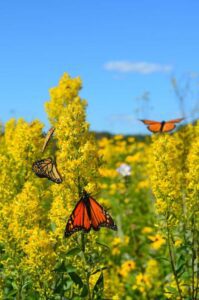
- Sun Exposure; Full–Partial
- Soil Moisture; Medium to dry
- Height 5 feet; Spacing 2-3 feet apart
- Yellow blooms September, October, November
- Less aggressive than some Goldenrods-not rhizomatous
- Will spread slowly forming clumps, but will not overwhelm
- Does not cause hay fever (ragweed causes hay fever)
- Important to ecosystem because of late blooming, etc.
- One of the showiest Goldenrods
Great Blue Lobelia; Lobelia siphilitica
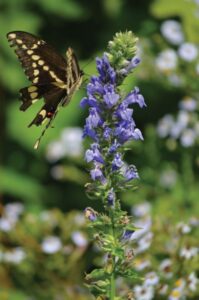
- Sun exposure: Full/partial
- Moisture: Moist to wet
- Height: 1-4 feet; space 1 foot
- Blooms: Narrow spike blue flowers in July-September.
- Attracts: butterflies, bees, hummingbirds,
- Deer resistant
- Blue counterpart to Cardinal Flower
Heliopsis; Heliopsis Helianthoides

- Sun exposure: Full, partial
- Moisture: Medium-wet; medium, medium-dry
- Yellow blooms June-September.
- Height 4-5 feet; space 18-24 inches
- Attracts many kinds of bees, butterflies, hummingbirds, songbirds
- Aggressiveness: medium by seed
- Also called Ox-eye Sunflower, Early sunflower, and False Sunflower
- First composite flower to show in spring
- Easy to grow and quick to develop
Hoary Skullcap; Scutellaria incana
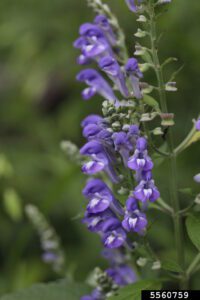
- Very hardy!
- Sunlight Exposure; Partial
- Soil Moisture: Medium to medium-dry; tolerates poor soil
- Height: 3 feet; Spacing 1-2 feet
- Showy blue blossoms June-September
- Attracts: Attracts many different pollinators, but primarily pollinated by bumblebees
- Deer resistant
- Aggressiveness; Forms colonies by rhizomes; also spreads by seeds
- Germination code: Cold-moist treatment for 60 days
Anise Hyssop; Agastache Foeniniculum
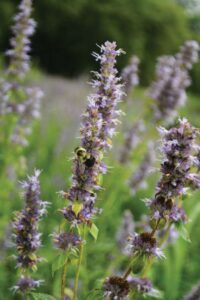
- Sun Exposure; Full/partial
- Soil moisture; Dry to medium
- Height 1-3 foot
- Blooms: Light blue/lavender flower spikes June,-September
- Attracts: Bees, butterflies, hummingbirds
- Aggressiveness: medium by seed
- Rich nectar -favorite of bees and hummingbirds.
- Anise Hyssop is a native prairie plant in the mint family.
- Leaves have a licorice, anise scent
- Square stem; self-seeds
Giant Purple Hyssop: Agastache urtocofp;oa
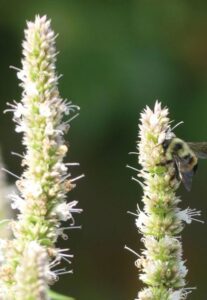
- Sun Exposure: Full/partial; Dappled shade
- Soil Moisture: Moist to wet
- Height: up to 6 feet
- Blooms: Purple blossoms July-October
- Attracts: Butterflies, bees, hummingbirds, Goldfinches
- For high nectar content; seeds
- Aggressiveness: not aggressive, in fact, needs attention to preserve
- Tend to be short-lived due to being out competed by more aggressive species
- Can be cut back in spring to promote more bushiness
- Sturdy square stems
- Threatened or endangered in some Eastern states
Common Ironweed; Vernonia fasciculata

- Sun Exposure: Full/part
- Moisture: medium to moist
- Height: 4-6 feet; spacing 2-3 feet
- Brilliant purple-deep pink blossoms July-September
- Aggressiveness: Low by seed
- Attracts: Bees, butterflies, songbirds
- Larval host to American Painted Lady butterfly
- May self hybridize with Tall and Missouri Ironweed
Missouri Ironweed; Veronica Missurica
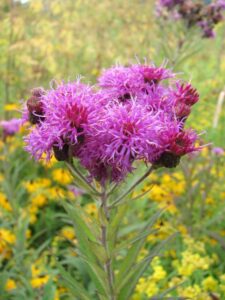
- Sun Exposure: Full sun
- Moisture: Medium-wet to Medium dry
- Height 5 feet; spacing 2-3 feet
- Showy magenta/purple blossoms July to October
- Attracts: Butterflies; larval source to some moths
- Late season nectar source
- Aggressiveness: Spreads by rhizomes
- Deer resistant
- Readily self-hybridizes with Common and Tall Ironweed
Tall Ironweed; Vernonia Gigantia
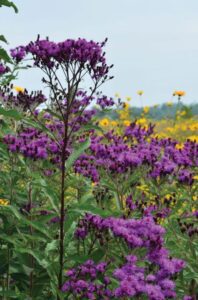
- Sun Exposure: Full/part
- Moisture: Moist to wet
- Height: 5-10 feet; spacing 2-3 feet
- Large showy purple-magenta blossoms July-September
- Attracts: Bees, butterflies, songbirds
- Aggressiveness: Spreads rhizomes and seeds
- Readily self-hybridizes with Missouri and Common Ironweed
- Deer resistant due to bitterness of leaves
Spotted Joe Pye; Eupatorium maculatum
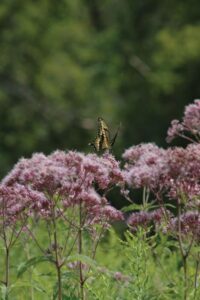
- Sun exposure; full, partial
- Moisture; Moist to wet
- Height; 5 feet; spacing 3-4 feet
- Pink blossoms July & August
- Attracts: magnet for many species of butterflies; as well as bees and songbirds
- Aggressiveness: low to medium;
- Large plant so plan placement carefully
- Deer palatability low
- Good for planting in drainage areas, along streambanks, and pond edges
Lead Plant; Amorpha canescens
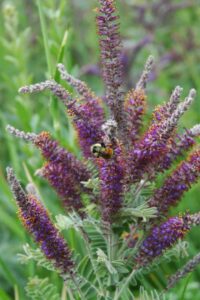
- Sun Exposure: full sun to light shade
- Soil Moisture; Dry to medium
- Height: 2-3 feet;
- Blossoms: Iridescent purple blossoms June; July
- Attracts: Bees, butterflies;
- Host to numerous butterflies and moths, including Eastern Tailed Blue, Southern Dogface Sulphur, Silver Spotted Skipper
- Foliage silver-gray even in heat of summer
- Deep taproot makes this plant drought tolerant
- Leaves: Grayish-green
- Small shrub; long tap root
Sweet Joe Pye; Eupatorium Purpureum
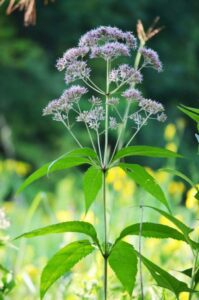
- Sun exposure; full, partial; can handle more shade than Spotted Joe Pye
- Moisture; Medium-wet to medium-dry
- Height; 6-7 feet; spacing; 3-4 feet
- Lavender, pink blossoms July-September
- Attracts: Favorite nectar source for Monarchs, Swallowtails, and other butterflies
- Aggressiveness: well-behaved due to shallow fibrous roots
- Will not interfere with other garden plants
- Deer resistant
Rose Mallow; Hibiscus laevis
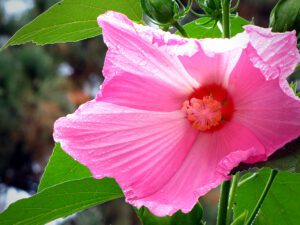
- Light Requirement; Full sun
- Moisture: Wet to medium-wet
- Height: 5 feet; spacing 2-3 feet
- Dramatic, large, plentiful pink blossoms July-September
- Spreads by seeds and rhizomes; easy to manage
- Attracts: Seeds eaten by birds; nectar for bees, butterflies, and other insects
- Massive root structure; stem may be more delicate, so planting with other upright plants may help, or stake them if necessary
- Germination code: Cold-moist stratification 60 days
Common Milkweed; Asclepias syriaca
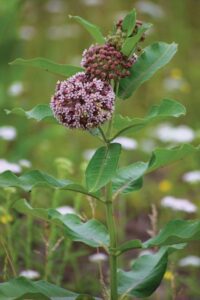
- Sun Exposure: Full sun to partial
- Moisture: Dry to moist
- Blooms: Pink/lavender blossoms are fragrant-
- Attracts: Bees and butterflies for nectar
- A favorite host plant for Monarch eggs & caterpillars
- Aggressiveness: High by rhizomes and seeds
- Easy to grow-very common in Iowa!
- Cut back mid-summer for new growth
- Best to plant in area where it is OK if they spread. Pair with robust prairie flowers and grasses to keep in check.
Red Swamp Milkweed; Asclepias Incarnata
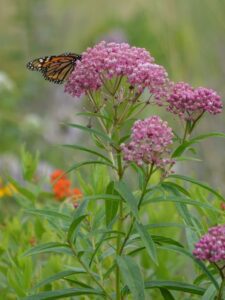
- Sun Exposure: Full sun
- Soil Moisture; Moist to wet
- Blooms: Red-pink blossoms in June-July
- Height; 3-5 feet; spacing; 12-18 inches
- Attracts: Birds, bees, butterflies, hummingbirds
- Larva plant for Monarch butterflies
- Aggressiveness: Medium by seeds; clumps get bigger
- Fibrous root system, not rhizomes, so it is not invasive
Butterfly Weed; Asclepias Tuberosa
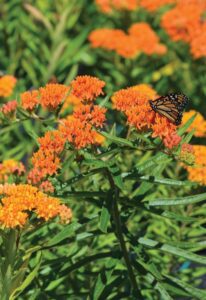
- Sun Exposure: Full
- Moisture: Dry to medium
- Height: 2-3 feet
- Blooms: Bright orange blossoms in June-August
- Attracts: Great nectar source for all kinds of bees and butterflies
- A host plant for Monarch eggs & caterpillars
- Aggressiveness; low by seeds
- Taproot not easily divided
Whorled Milkweed
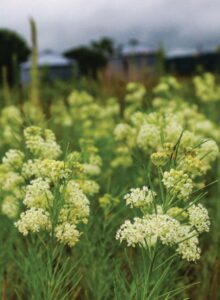
- Sun Exposure; Full – Partial
- Soil Moisture; Medium wet to medium dry
- Height 3 feet; Spacing 1-2 feet
- Short lived, but will self-seed
- Yellow blooms April, May, June
Caution-it can be confused with non-native Wild Parsnip, although parsnip is taller and blooms later; Parsnip can cause painful skin burns.
Slender Mountain Mint; Pycanthemium tenuifolium
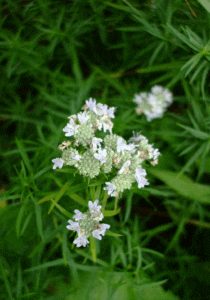
- Sun Exposure: full to partial
- Moisture: Medium-wet to Medium-dry
- Blooms: White blooms July-September
- Attracts: Bees, butterflies
- Height: 1-4 feet; Space 12-18 inches apart
- Aggressiveness: Medium by rhizomes, but easily controlled
- Has mint aroma
- Deer resistant
Nodding Onion; Allium cernuum
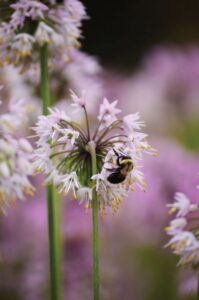
- Sun exposure: Full-partial
- Soil Moisture; medium-wet; Medium-dry
- Height 1-2 feet; spacing 4-8 inches
- Blooms: White-pink blossoms June-August
- Attracts; Bees, because they can nectar upside down
- Aggressiveness: Medium by seed
- Easy to grow and will gradually spread by seed and bulb offshoots
- Plant in mass for stunning display
- Deer resistant
Obedient Plant; Physostegia virginiana
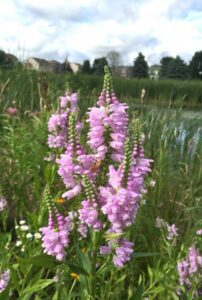
- Sun requirement: Full sun, light shade
- Soil Moisture; Medium to wet
- Height 1-2 feet
- Blooms: Pinkish purple blooms; August-September
- Attracts: Bees, butterflies, hummingbirds
- Aggressiveness: High by rhizomes
- Square stems
- Gets its name because it is said that if you manipulate the flower, it will stay where you put it. It does not apply to its behavior in the garden, as it will spread- but a good spread.
Ohio Spiderwort;Tradescantia Ohiensis

- Sun Exposure: Full-Partial
- Soil moisture: Medium-wet to medium-dry
- Height; 2-4 feet; spacing- 12-18 inches
- Blooms: Blue blossoms May-July
- Attracts: Native Bees
- Tolerates poor soils and tough growing sites
- Blooms open in AM and close in PM
Partridge Pea; Symphyotrichum oblongifolium
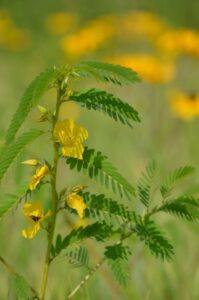
- Sun Exposure; Full/part
- Soil Moisture: Medium-dry
- Height: 2 feet; Spacing 12-18 inches
- Yellow blossoms July-September
- Attracts: Bees, other pollinators; seeds attract songbirds
- Is an annual, but reseeds readily
- Larval host of Little Yellow, Sleepy Orange, and Orange Sulfur butterflies
- Is a legume so aid in fixation of atmospheric nitrogen and improve health of native plant communities
Pasque Flower; Pulsatilla patens var. multifida
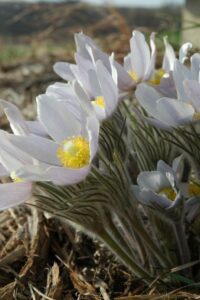
- Sun Exposure: Full sun
- Soil Moisture: Dry
- Height: 6-12 inches
- Blooms: White blossoms April-May
- Attracts: Bees
- Aggressiveness: low by seed
Garden Phlox; Phlox paniculata
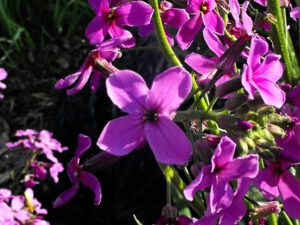
- Native variety (many cultivars available in garden centers)
- Sun Exposure; Full/partial
- Soil Moisture: Wet to medium-wet
- Height: 4 feet; Spacing 2-3 feet
- Deep pink blossoms July=September
- Attracts: Bees, butterflies, especially Swallowtails
- Aggressiveness; Medium by rhizomes
- Germination code: Cold-Moist 60 days
- Keep seeds refrigerated until planted
- Spreads to 2-3 feet
- Plant in area with good ventilation
Prairie Smoke; Geum triflorum

- Light Exposure: Full sun
- Soil Moisture: Dry to medium
- Height: 6 inches
- Blooms: Pink blossoms; May-June; Noted more for fluffy seedheads
- Attracts: Bees, butterflies
- Aggressiveness: Low by seed and rhizome
- Rhizomes can easily be divided.
Purple Prairie Clover; Dalea Purpurea

- Sun Exposure: Full sun preferred
- Soil Moisture; Medium to dry
- Height 1-2 feet; Spacing: 18”-24”
- Blooms: Purple blossoms in July-September
- Attracts: Bees, butterflies, game birds, song birds
- Aggressiveness: Low by seed
- Larval host for Dogface Sulpher butterfly
- Legumes harbor beneficial bacteria called rhizobia that enables plants to capture nitrogen from air and “fixing” it in the plant.
- The plant material fertilizes the soil when it is spent.
- Long tap root supports a long-lived plant
- Deer palatability: High
Rattlesnake Master; Eryngium Yuccifolium
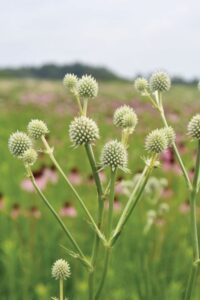
- Sun Exposure: Full/partial
- Soil Moisture: Medium wet-medium dry
- Height: 4 feet; Spacing 18-24”
- Bloom are bristly flowers in June-August
- The bristly blooms and course leaves make it largely ignored by deer and rabbits.
- Nectar source for small bees and moths
- Aggressiveness: Medium by seed
- Interesting texture addition to your garden
- Native to Iowa
River Oats; Northern Sea Oats; Adamantium latifolium
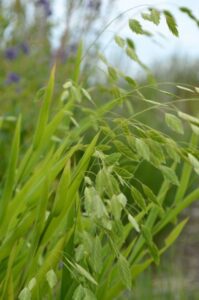
- Light Requirement; Full/partial
- Moisture: Moist
- Height: 3 feet
- Aggressiveness; Reseeds and spreads by rhizomes
- Attracts: Seeds eaten by birds and small mammals
- Food for larva of several species of Skippers
- Will form nice ground cover over time
- Very Ornamental grass
Prairie Sage; Artemesia ludoviciana
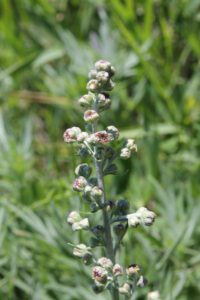
- Sun Exposure: Full-partial
- Soil Moisture: Medium to dry
- Height: 3 feet
- Attracts: Many pollinators
- Green blooms July to September
- Leaves have aroma which may deter herbivores like rabbits and deer
- Larval host to American Lady and Painted Lady butterflies
- Plants are easily propagated; When plants reach 3, can do tip cuttings in early summer, or by divide mature plants in early summer
- Spreads by rhizomes to form colonies; aggressive
- Germination code: Cold-moist treatment 30 days; seeds need light to germinate
- This species is the sage used in Sage Bundles for smudging and ceremonial purposes by many Native American tribes.
Spotted Bee Balm Monarda Punctata
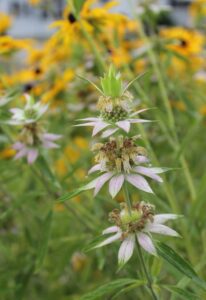
- Sun Exposure; Full/partial
- Soil Moisture; Medium Dry-Dry soil; Drought tolerant
- Height 2 feet; space 8-12 inches apart
- Complex Purple blossoms July-September
- Attract Honey, Bumble bees, & many butterflies
- Rarely eaten by mammals
- Also called Spotted Mint or Dotted Horsemint
St. Johnswort; Hypericum pyramidatum
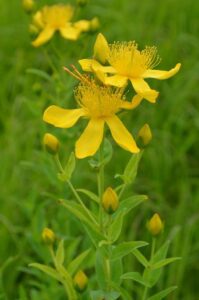
- Sun Exposure: full-part
- Soil Moisture: moist-wet
- Height: 4-6 feet
- Blooms: Yellow blossoms June-August
- Attracts: Bees, butterflies
- Aggressiveness: low by seed
- Good companion of Culver’s Root
Blue Vervain; Verbena hastata
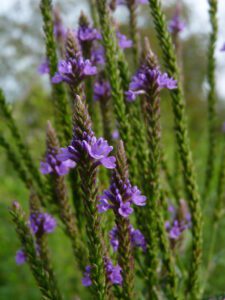
- Small purple blooms June-September.
- The narrow spike flowers
- Height 4-5 feet; space 18-24 inches
- Sun exposure: Full, partial
- Moisture: Wet, Medium-wet; medium
- Short lived, but self-seeds
- Native
Virgina Bluebells; Mertensia virginica
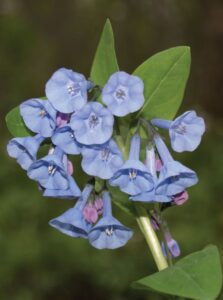
- Sun Exposure; Partial to shade
- Soil Moisture: medium to moist
- Height; 1-2 feet; spacing- 12-18 inches
- Pink-blue blossoms April – May
- Prefer rich well drained soil; ;natural leaf mulch will enrich soil
- Attract bumblebees, mason bees
- Rhizome root system
- Expand slowly, long lived
- Beautiful woodland ephemeral
White Snakeroot; Ageratina altissima

- Sun Exposure; Full-Partial
- Soil Moisture; Medium-Wet to Medium-Dry
- Height 2 feet
- branching clusters
- Blooms: White flat topped flowers July-September
- Attracts: Bees, butterflies, moths
- Aggressiveness: Spreads by rhizomes; is a prolific self-seeder
- Once a colony is established, it grows respectfully among other natives
- Deer resistant
- Common to woodland edges
- Poisonous to mammals if ingested: source of milk poisoning if cows ingest it
Wild Bergamot; Monarda Fistulosa
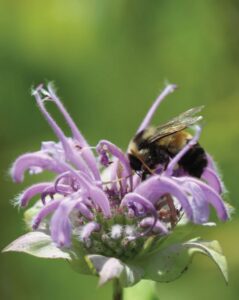
- Sun Exposure; Full/partial
- Soil Moisture; Dry, medium, moist
- Height; 4’; 2’ spacing
- Bloom: Lavender blossoms July-September
- Attracts bees, hummingbirds, butterflies; deer resistant
- Aggressiveness: medium by seed and rhizome
- Mint family-square stems; aromatic leaves
- Complements yellow composite flowers such as Black-Eyed Susan and Heliopsis
- Plant with other vigorous flowers and grasses to prevent too much spreading

